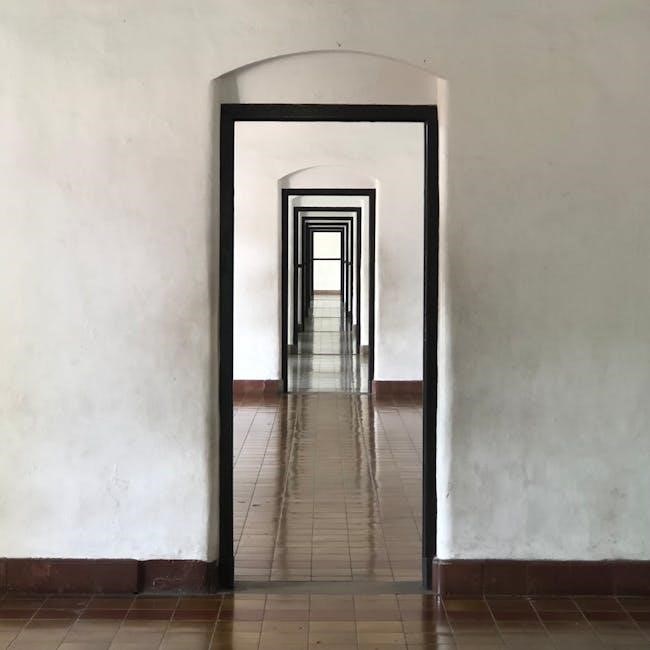doors of perception pdf
Aldous Huxley’s The Doors of Perception PDF explores consciousness and perception through his mescaline experience, offering deep insights into the human mind and reality.
1.1 Overview of the Book
The Doors of Perception is a 1954 philosophical essay by Aldous Huxley, detailing his experiences with mescaline. The book explores altered consciousness, perception, and reality, offering profound insights into the human mind. Available as a PDF and ePUB, it remains a pivotal work in psychedelic literature, blending personal narrative with philosophical reflections on existence and the nature of reality.
1.2 Aldous Huxley’s Contribution to Psychedelic Literature
Aldous Huxley’s The Doors of Perception is a landmark in psychedelic literature, offering a deeply intellectual and philosophical exploration of altered states. Huxley’s articulate and systematic account of his mescaline experience influenced both the counterculture movement and academic discourse, bridging science and mysticism. His work remains a cornerstone, inspiring further exploration of consciousness and perception, and cementing his legacy as a pioneer in the field.
Historical Context of the Book
The Doors of Perception emerged in 1954, a period of growing interest in psychedelics and consciousness exploration. Huxley’s work bridged science and philosophy, influencing future discussions on perception and reality while sparking curiosity about altered states of consciousness during a transformative era.
2.1 Publication and Initial Reception in 1954
Published in 1954, The Doors of Perception initially sparked curiosity and debate. Huxley’s detailed account of his mescaline experience intrigued both scientific and literary communities. While some praised its insightful exploration of consciousness, others criticized its perceived promotion of drug use. The book quickly became a focal point in discussions about perception, reality, and the potential of psychedelics, setting the stage for future countercultural movements.
2.2 The Role of Mescaline in Huxley’s Experiment
Mescaline, a psychoactive alkaloid from the peyote cactus, played a central role in Huxley’s experiment. It induced profound alterations in perception, vivid visuals, and a sense of time dilation. Huxley documented these effects meticulously, exploring how the drug revealed hidden layers of consciousness. His experience with mescaline formed the foundation of The Doors of Perception, offering insights into the nature of reality and human cognition.
Scientific and Philosophical Basis
The Doors of Perception explores the intersection of science and philosophy, blending Huxley’s empirical observations with metaphysical reflections, offering a unique lens to understand consciousness and reality.
3.1 The Effects of Mescaline on Human Consciousness
Mescaline profoundly alters perception, intensifying sensory experiences and distorting time. Huxley describes vivid visuals, heightened colors, and patterns, revealing a world beyond ordinary awareness. The drug induces a state of deep introspection, dissolving boundaries between self and universe, offering insight into the nature of consciousness and existence. This transformation challenges conventional understanding of reality and perception.
3.2 Huxley’s Interpretation of Blake’s “Doors of Perception”
Huxley interprets Blake’s metaphor as a gateway to heightened consciousness, where perception transcends the ordinary. He views mescaline as a tool to “cleanse the doors of perception,” revealing profound insights into existence. This aligns with Blake’s vision of perceiving infinity in a grain of sand, emphasizing the interconnectedness of all things and the potential for transcendence through altered states of awareness.

The Psychedelic Experience Described
Huxley’s account explores the transformative nature of the psychedelic experience, detailing altered perception, heightened sensory awareness, and profound introspection into the essence of reality and consciousness.
4.1 Huxley’s Personal Account of Mescaline Use
Huxley ingested 400 mg of mescaline, documenting his journey from initial anxiety to profound visual and perceptual transformations. He described heightened sensitivity to color, texture, and spatial relationships, observing everyday objects with newfound depth. The experience, marked by a sense of time dilation and philosophical introspection, profoundly influenced his understanding of consciousness and reality, as detailed in The Doors of Perception.
4.2 Sensory Alterations and Expanded Perception
Huxley’s mescaline experience transformed his senses, with vivid visuals, intensified colors, and altered spatial awareness. He observed intricate patterns and textures, experiencing synesthesia-like sensations. Time and space expanded, blending past and present. This expanded perception revealed the interconnectedness of all things, offering profound philosophical insights into the nature of existence and human awareness.

The Book’s Central Themes
The book explores the nature of reality, perception, and consciousness, highlighting psychedelics’ potential for self-discovery and spiritual insight, challenging conventional views of human existence.
5.1 The Nature of Reality and Human Perception
Huxley delves into the nature of reality and perception, suggesting that psychedelics reveal the limitations of human senses. He proposes that our brains act as filters, narrowing our view of reality. Through mescaline, he experienced a more vivid and interconnected world, challenging the notion of an objective reality. This exploration raises profound questions about consciousness, the human condition, and the potential for expanded perception.
5.2 The Potential of Psychedelics for Self-Discovery
Huxley believed psychedelics could unlock profound self-discovery by bypassing the rational mind. His experience revealed deep emotional and philosophical insights, suggesting these substances could facilitate introspection and personal growth. By altering consciousness, psychedelics might help individuals transcend ego-bound perspectives, fostering a deeper understanding of themselves and existence. This idea aligns with contemporary research into psychedelics’ therapeutic potential for mental health and self-awareness.
Cultural and Intellectual Impact
“The Doors of Perception” deeply influenced 1960s counterculture, inspiring thinkers, artists, and the psychedelic movement, while reshaping societal views on consciousness and perception.
6.1 Influence on the Counterculture Movement of the 1960s
Huxley’s work became a cornerstone of the 1960s counterculture, inspiring explorations of consciousness and challenging mainstream values. It influenced figures like Timothy Leary and shaped the era’s emphasis on psychedelic experiences. The book’s themes of perception and reality resonated with the movement’s pursuit of spiritual and intellectual freedom, making it a defining text for a generation seeking transformative experiences and societal change.
6.2 The Book’s Role in Popularizing Psychedelic Research
“The Doors of Perception” played a pivotal role in popularizing psychedelic research by bringing attention to the potential of substances like mescaline for scientific study. Huxley’s vivid account sparked curiosity among researchers and the public, inspiring further exploration into the therapeutic and cognitive effects of psychedelics. His work laid the groundwork for modern studies and remains a foundational text in the field.

The Doors of Perception and Modern Science
Huxley’s work has inspired modern scientific studies on psychedelics, bridging philosophy with neuroscience to explore consciousness and perception.
7.1 Advances in Psychedelic Research Today
Modern studies on psychedelics, like psilocybin and LSD, explore their therapeutic potential for mental health conditions, aligning with Huxley’s insights. Neuroimaging techniques reveal how these substances alter brain activity, fostering deeper understanding of consciousness. Clinical trials demonstrate reduced symptoms of depression and anxiety, offering new hope. These advancements build on Huxley’s philosophical exploration of perception, bridging science with his visionary ideas.
7.2 Neuroscientific Insights into Altered States
Modern neuroimaging reveals how psychedelics alter brain connectivity, particularly in the default mode network. Studies show reduced activity in self-referential thought hubs, leading to ego dissolution and expanded perception. These findings align with Huxley’s descriptions of transcendent experiences, offering scientific validation of his philosophical musings on consciousness and reality.

The Book’s Legacy
“The Doors of Perception” remains a cornerstone of psychedelic culture, inspiring philosophical debates and artistic movements while continuing to influence contemporary discussions on consciousness and perception.
8.1 Continued Relevance in Contemporary Discussions
Despite being written decades ago, “The Doors of Perception” remains a pivotal text in modern discourse on consciousness, psychedelics, and perception. Its exploration of altered states continues to inspire scientific research, philosophical debates, and cultural conversations, bridging the gap between the counterculture movement of the past and today’s growing interest in psychedelic therapies and cognitive exploration.
8.2 Adaptations and References in Popular Culture
“The Doors of Perception” has deeply influenced art, music, and media. The rock band The Doors adopted its name, reflecting the book’s themes of perception and consciousness. Documentaries, films, and literary works often reference Huxley’s insights, showcasing its enduring impact on popular culture and its ability to inspire creative expression across genres.

Availability and Formats
“The Doors of Perception” is widely available in paperback, hardcover, and digital formats, including PDF and ePUB. Free versions can be found online, but legality varies.
Purchasing from reputable stores or libraries ensures legal access to Huxley’s timeless work.
9.1 The Doors of Perception PDF and ePUB Versions
“The Doors of Perception” is available in PDF and ePUB formats, accessible through online retailers like Amazon and Google Books. Many websites offer free PDF downloads, but verify legality in your region. Purchasing ensures quality and supports authors. ePUB versions are optimized for e-readers, providing a seamless reading experience. Additionally, libraries often offer digital lending options for Huxley’s works.
9.2 Free Online Resources and Downloads
Free PDF versions of “The Doors of Perception” can be found on platforms like Project Gutenberg, ManyBooks, and Google Books, though availability may vary by region due to copyright restrictions. Public libraries often provide free e-book loans through services like OverDrive. Ensure compliance with local laws when accessing free downloads to avoid copyright infringement issues.

Related Works by Aldous Huxley
Aldous Huxley’s “Heaven and Hell” and “Brave New World” explore similar themes of perception, consciousness, and societal critique, offering deeper insights into his philosophical and literary vision.
10.1 “Heaven and Hell” as a Companion Piece
Aldous Huxley’s “Heaven and Hell” serves as a companion to “The Doors of Perception”, exploring the darker side of visionary experiences. It delves into the contrasting themes of transcendence and despair, offering a balanced view of altered states. Huxley examines the duality of human perception, emphasizing the potential for both enlightenment and madness. This work complements his earlier exploration, providing a nuanced understanding of consciousness and reality.
10.2 Huxley’s Other Explorations of Consciousness
Beyond “The Doors of Perception”, Aldous Huxley explored consciousness in works like “The Perennial Philosophy” and “Island”. These writings delve into mystical experiences, the nature of the self, and the potential of psychedelics for spiritual growth. Huxley’s broader oeuvre reflects his fascination with the human mind and its capacity for transcendence, offering readers a holistic view of his philosophical and scientific inquiries.
Ethical and Moral Considerations
Huxley’s work sparks debates on the ethical use of psychedelics, emphasizing responsible consumption and awareness of their transformative power.
11.1 The Risks and Benefits of Psychedelic Use
Huxley’s work highlights the dual nature of psychedelics, offering profound insights but also posing risks if misused. While mescaline expanded his perception, he cautioned against recreational use, advocating for controlled, mindful exploration. The book underscores the importance of context and intent, balancing potential therapeutic benefits with the dangers of unchecked experimentation.
11.2 Huxley’s Views on Responsible Substance Use
Huxley emphasized the importance of mindful and controlled substance use, advocating for intentional exploration rather than recreational indulgence. He believed psychedelics could unlock profound insights but stressed the need for a stable mindset and guidance. His approach highlighted the balance between potential benefits and risks, promoting responsible use to avoid harm and maximize transformative experiences.

The Book’s Influence on Art and Music
The Doors of Perception inspired 1960s counterculture, influencing iconic bands like The Doors, named after the book. Its themes of perception and reality also shaped psychedelic art and music, inspiring Jimi Hendrix and Pink Floyd to explore new creative frontiers.
12.1 Inspiration for Artists and Musicians
Aldous Huxley’s “The Doors of Perception” deeply influenced 1960s counterculture, inspiring artists and musicians to explore altered states of consciousness. The book’s vivid descriptions of sensory transformations resonated with creators like Jimi Hendrix and Pink Floyd, who incorporated psychedelic themes into their work. Its philosophical insights also inspired visual artists to experiment with vibrant, mind-bending designs, reflecting the era’s fascination with perception and reality.
12.2 The Doors of Perception and the Emergence of Psychedelic Art
Aldous Huxley’s recounting of his mescaline experience in The Doors of Perception influenced the rise of psychedelic art. The book’s vivid descriptions of distorted perceptions and heightened sensory experiences inspired artists to create visually striking, abstract works. This aligns with the 1960s counterculture, where psychedelic art flourished, reflecting the exploration of consciousness and reality through vibrant, mind-altering visuals.

Critical Perspectives and Debates
The Doors of Perception sparked debates about its scientific validity and philosophical implications. Critics argue its subjective nature lacks empirical support, while admirers praise its profound insights into consciousness and perception.
13.1 Scientific Criticism of Huxley’s Findings
Huxley’s account in The Doors of Perception has faced scientific criticism for its subjective nature and lack of empirical validation. Critics argue that his experiences, while vivid, are anecdotal and not replicable under controlled conditions. The absence of measurable data and Huxley’s reliance on personal interpretation have led some to question the scientific rigor of his conclusions about mescaline’s effects on perception and consciousness.
13.2 Philosophical Debates on Perception and Reality
Huxley’s work sparks philosophical debates about the nature of perception and reality. His experiences challenge the notion of an objective reality, suggesting that perception is filtered through the mind. Philosophers question whether altered states reveal deeper truths or create subjective illusions. This ties into discussions about consciousness, the limits of human understanding, and the relationship between the self and the external world.

The Doors of Perception in Academic Studies
Scholars explore Huxley’s work in psychology, philosophy, and cognitive science, analyzing its insights into perception and consciousness, making it a foundational text in interdisciplinary studies.
14.1 Use in Psychology and Cognitive Science Courses
The Doors of Perception is widely used in academic settings to explore perception, cognition, and consciousness. Its detailed account of altered states provides a unique lens for studying the brain’s processing of sensory information. Educators often incorporate the text to discuss the neural basis of perception and the psychology of subjective experience, making it a valuable resource for interdisciplinary studies;
14.2 The Book’s Impact on Academic Research
The Doors of Perception has significantly influenced academic research in psychedelics, cognition, and consciousness studies. Huxley’s detailed account of mescaline’s effects sparked scientific interest in altered states of consciousness. Researchers have used his observations to explore perception, neurobiology, and the psychology of subjective experience, making the book a foundational text in interdisciplinary studies of the mind and its potential.
Personal Reflections and Reader Experiences
Readers often describe The Doors of Perception as life-changing, inspiring introspection and curiosity about consciousness. Many find Huxley’s narrative deeply relatable, sparking personal journeys of self-discovery and exploration.
15.1 Reader Responses to Huxley’s Narrative
Readers of The Doors of Perception often praise Huxley’s vivid descriptions and philosophical insights, finding his account both captivating and thought-provoking. Many report feeling inspired to explore consciousness and perception, while others critique his interpretations. The accessible language in the Doors of Perception PDF has made it easier for audiences to engage with his ideas, fostering widespread discussion and personal reflection on altered states of mind.
15.2 The Book’s Role in Inspiring Personal Exploration
The Doors of Perception has long inspired readers to explore their own consciousness and perception. The availability of the Doors of Perception PDF has made Huxley’s insights more accessible, encouraging individuals to reflect on their experiences and question reality. Many have reported feeling motivated to embark on personal journeys of self-discovery, blending introspection with a deeper understanding of human potential and existence.
The Doors of Perception remains a profound exploration of consciousness and reality, offering timeless insights into human perception. Its enduring influence ensures continued relevance in modern discourse.
16.1 The Enduring Significance of “The Doors of Perception”
The Doors of Perception continues to captivate readers with its profound insights into consciousness, perception, and reality. Huxley’s exploration of mescaline’s effects resonates deeply, bridging science, philosophy, and art. Its influence spans countercultural movements, psychedelic research, and modern philosophy, ensuring its relevance in contemporary discussions. The book remains a cornerstone of exploring human consciousness and the nature of existence.
16.2 Final Thoughts on Perception, Consciousness, and Reality
Huxley’s work challenges readers to reconsider the nature of perception and reality. By exploring altered states, he underscores the limitations of human consciousness and the potential for transcendence. His insights resonate today, inspiring both scientific inquiry and philosophical reflection. The Doors of Perception remains a timeless exploration of the human experience, urging us to question, seek, and understand the depths of existence.










